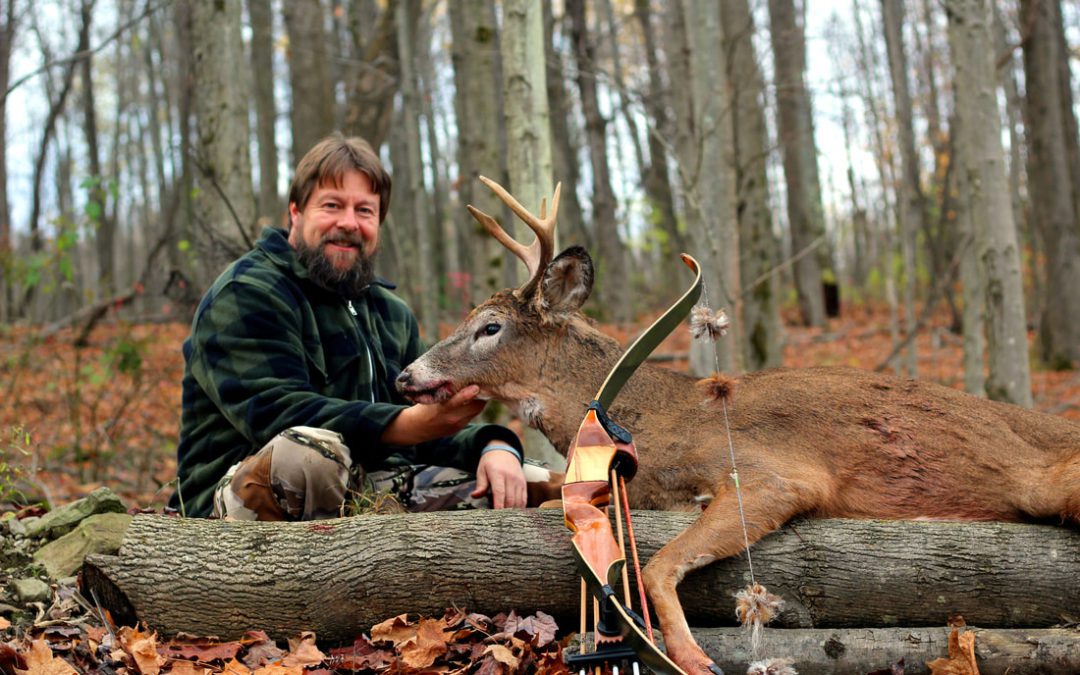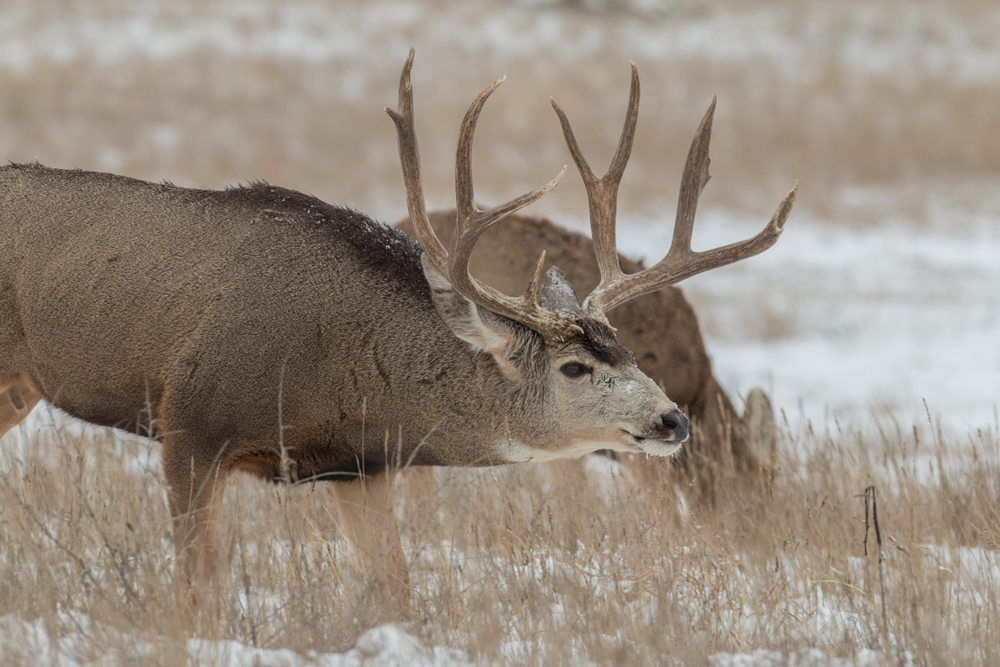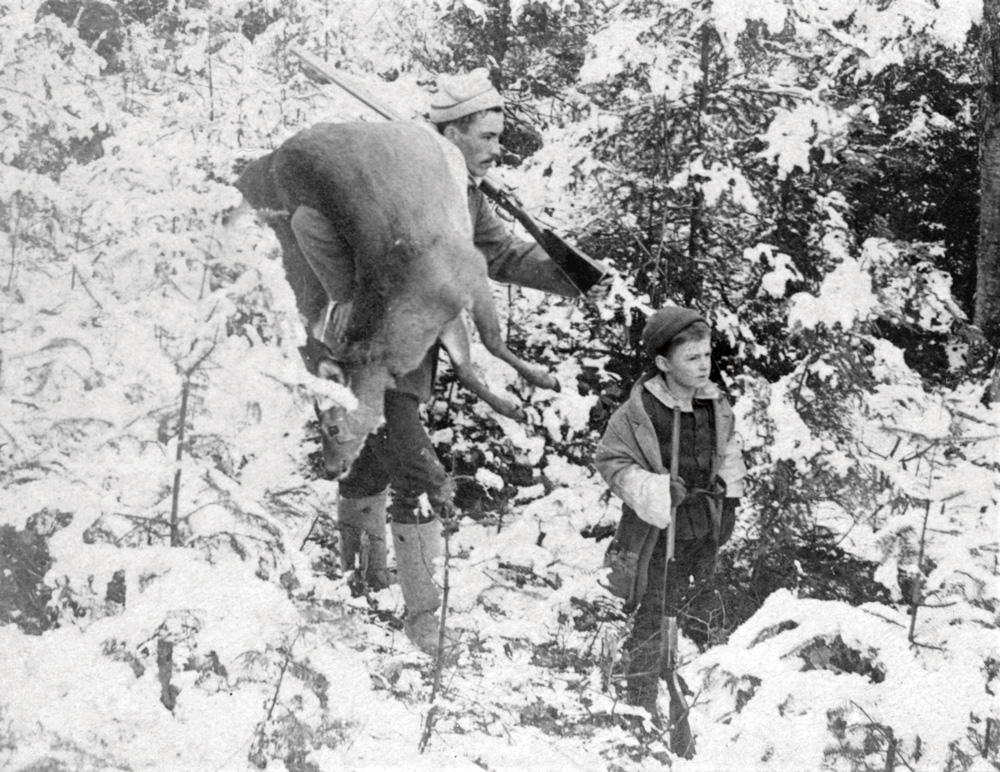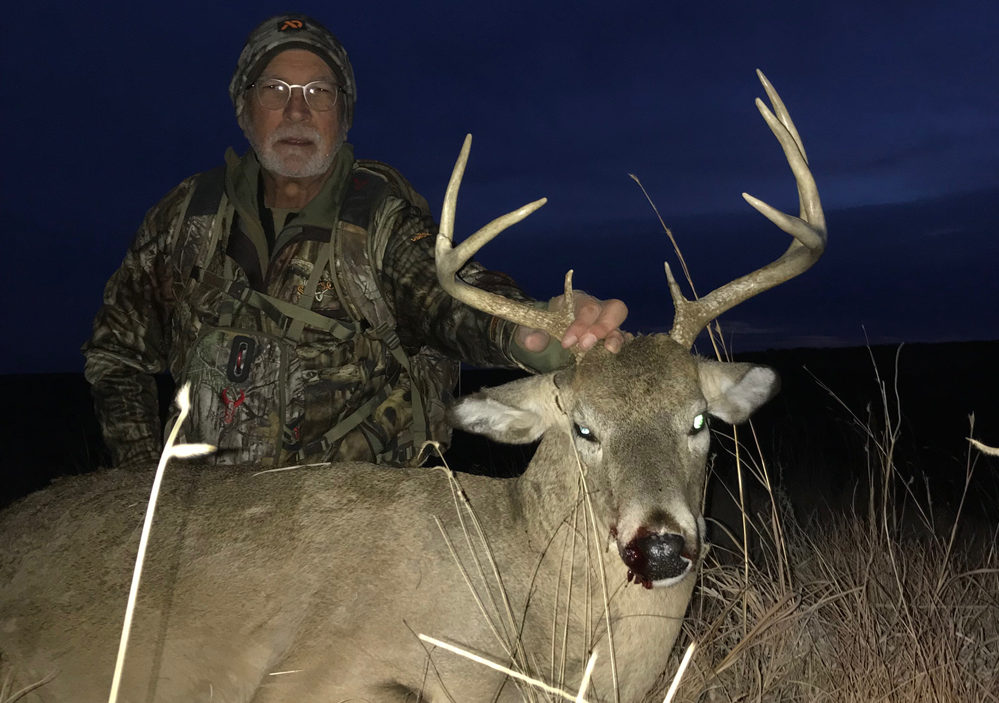One of the most frequent questions I’m asked is, “How do you go about hunting whitetails from the ground with a bow?” With the availability of cheap and easy-to-use treestands, it seems that hunting from the ground is a craft that’s being lost. Here’s a short story about a buck I took this year, followed by a deeper dive into ground hunting.
Dwight D. Eisenhower once said, “Plans are nothing; planning is everything.” So it was on November 3 of this year’s bow season. The plan was to set up an ambush at the intersection of a faintly used deer trail leading from a cut-over CCC-era red pine plantation and a deer superhighway leading to a cluster of overgrown apple trees. The faint trail was a good bet for one of two good bucks that I knew bedded in the old red pines, and the superhighway would almost guarantee me a doe. I just needed to get in a tree on the downwind side of the intersection.
When I arrived with a climbing stand on my back, it was clear the plan was just as Eisenhower had predicted—nothing! The planning had gotten me to this perfect deer hunting scenario, but the plan had failed to predict how the steep mountain ridge to my west would turn the steady northwest wind into a swirl that most often puffed out of the northeast. I had to rethink both my approach and setup.
I backed out and made a loop of 200 yards to avoid tainting potential shooting lanes with my footfalls. However, once on the downwind side of the trail intersection, I realized there were no trees in suitable positions for my climber. So I backed out and headed home for a beer . . .
Not! Hunting is sometimes making lemonade out of lemons. A deeper evaluation of the options revealed a solution.
In just the right spot, 18 yards from the intersecting trails, stood a gnarly white pine with its lower trunk growing in an “S” pattern, so the four-foot-long horizontal portion stood about three feet above the ground. I stashed my climber 50 yards away and returned to the white pine. I was able to sit on the horizontal trunk while resting my back against the vertical portion to block my silhouette. Also, the shade provided by the dense pine foliage put me in the inky shadows. This was just enough concealment to hide my form . . . provided I didn’t move at the wrong time.
The rest of this story is pretty textbook. I didn’t see a deer until 30 minutes before dark, when a big-bodied, 2½-year-old six-point slipped down the faint trail from the pines. He was a buck that I wouldn’t have shot from a treestand, but I considered him a trophy from my makeshift ground blind. When his head went behind a white ash, I took the opportunity to draw. I then had to track his chest for about ten yards until he cleared some dogwood brush, giving me a clear shot.
The arrow was as true as any I had ever released. The buck lunged forward before making a “J” pattern back toward the pines, revealing red smudges on each side of his chest. I looked down at the 1967 Shakespeare Ocala resting in my lap and wondered how many “notches” it had achieved in its 50 seasons.
For 15 minutes I sat quietly with my new white pine friend, reflecting on how hunting connects us to the animals, the landscape, and our own spirit like no other activity I know. I didn’t even bother to take up the blood trail, instead walking straight to the place I last heard crashing sounds, where I found the buck wedged against a tree. It was now nearly dark, and I headed home to retrieve my son Rex to help me with the extraction. This was Rex’s fourth buck retrieve, and he’s not yet 4 years old.
This hunt was a little unusual in that I switched strategies midstream. Below, excerpted from A Traditional Bowhunter’s Path, I describe how I would typically prepare for a ground-based hunt:
Everyone knows that to kill whitetails with a bow you have to be at least 15 feet off the ground, right? Wrong. Today’s combination of safe, inexpensive portable treestands and an extreme focus on hunting trophy bucks has turned ground hunting into a dying art—a trend that’s likely causing bowhunters to miss out on some great opportunities and a lot of fun. On nearly every property I hunt, there are excellent ambush sites that offer no possibility of placing effective treestands. I emphasize the word “effective” because there are sometimes trees available, but those in poor position relative to deer movement don’t offer shot opportunities, and trees with too little cover are a sure recipe for getting busted.
Deer move in spatial patterns governed by food, habitat structure, topography, and wind direction. Bucks especially like to move in thick cover or on the edge of it, like where a thicket meets a swamp or field. It’s no coincidence that thick places have few trees, as tree canopies block sunlight, which prevents development of brushy security cover. In my area of upstate New York and much of the Northeast, farm abandonment during the past 50 years has created a plethora of brush-choked fields that provide bedding cover and food but few trees for hanging a stand. I would guess that many of the very best areas for daytime deer activity go unexplored by bowhunters who think that hunting on the ground is a waste of time.
Hunting mature bucks is fun, and I don’t deny that it turns my “bowhunting crank,” but in my family, home-grown venison is our primary source of red meat, so filling the freezer is just as important. For the experienced hunter, shooting does can get a little routine, especially in farmland and suburban areas where deer are abundant and relatively easy to ambush from elevated stands. So a while back I started spending more time on the ground for the added challenge. Getting down to earth has taught me a lot about deer behavior and what works and what doesn’t when you’re at eye level with them. The main principles of successful deer hunting are the same whether you are aloft or planted on the ground, but there are some nuances. It’s all about fooling a deer’s senses.
Be Easy on Their Eyes
Many hunters believe that if you are on the ground, you must be totally hidden within a pop-up blind or wall of brush. I’ve actually found that having complete concealment isn’t necessary and is sometimes a liability because it limits your line of sight and effective shooting zones. I like to set up with a sparse screen of brush or mesh fabric in front of me and a visually complicated backdrop behind me. Good backgrounds include upturned stumps, the dense tops of fallen trees, thick shrubs such as rose or honeysuckle, and rocky outcrops. The idea is to break your silhouette, not completely hide your form.
My standard setup is a lightweight folding, aluminum stool and a 24-inch-tall skirt-type blind, which is nothing more than camo fabric attached to telescoping fiberglass stakes. With these items attached to my backpack, I can be set up in a few minutes. Brush blinds work great if they are built ahead of time, but for shrewd whitetails, building an impromptu blind can cause too much visual disturbance and leave behind a web of scent trails.
If I’m hunting an open area where I know that it’s difficult to find a good backdrop, I’ll often wear a ghillie suit. One note of caution: ghillie suits are great at breaking the human silhouette, but they are not so great for unfettered bow shooting. I strongly suggest practicing in your full suit and trimming the cloth strands that interfere with the travel of your bowstring.
When evaluating your ground setup, try to imagine how a deer might see the situation. As a prey animal, a deer’s eyes are positioned on the sides of its head, allowing for a 310-degree field of view and an excellent ability to sense movement but poor depth perception. Deer are able to see some color, especially in the blue to yellow-green spectrum, and there is evidence that their color vision might help them see shifting patterns of dark and light, which could contribute to their uncanny ability to sense movement.
For example, deer probably do not see the color orange as we do, but they can likely see the unusual brightness of fluorescent orange, especially if it’s moving against a darker background. To minimize the relative difference between ourselves and our backgrounds, I like darker colors for ground hunting and lighter colors for treestands.
A recent study conducted at the University of Georgia points to other differences between the vision of humans and deer. The human retina contains a region called the optic fovea, which supports a high concentration of cone cells and about half the eye’s optic nerves. These characteristics give humans an unusual ability to see fine details. In contrast, a deer’s cone cells lie in a dispersed horizontal streak across the eye.
These differences suggest that deer vision, in human terms, should be about 20/200, meaning that a deer’s ability to detect detail at 20 yards is about the same as a human’s at 200 yards. This is likely why deer are often more puzzled than scared by a motionless hunter. In my experience, the keys are to stay in the shadows, make sure you have adequate back cover, and, mostly importantly, limit your movement.
If you’re nestled in heavy cover, such as a cattail marsh or standing cornfield, cut a few narrow sight windows to either side of your shooting lane so you can see deer coming and be prepared. Otherwise, if a deer pops from the cover unexpectedly, you’ll have to make too much movement to get ready.
The key is to be in position before the deer steps into your shooting lane. In open habitats, such as field edges and power-line cuts, it’s good to give the deer something to focus on other than you. Deer decoys work best, but they are often cumbersome and can be dangerous to use when hunting from the ground, especially during firearm seasons. An alternative is to use a turkey decoy, which will focus a deer’s attention and give it confidence that everything is safe.
Several seasons ago, during New York’s late archery season, I pushed the limits of good sense by setting up on the ground in a large opening with little cover. It was too cold to crawl up in a tree, and the unusual east wind didn’t allow me to hunt from my usual ground blind on the opening’s opposite side. I hoped my doe decoy would keep any passing deer well distracted so I could draw my bow unseen.
It worked, in the middle of a wicked snow squall—a year-and-a-half-old doe tarried too long at my decoy, giving me just the chance I needed. The shot was true, adding some much appreciated venison to the freezer.
Nullify Their Noses
Deer are notorious for their acute sense of smell. Scent molecules from our bodies drift from a treestand like snowflakes on a gentle breeze. On a day with consistent wind, we can use this to our advantage, as a deer approaching from upwind can move downwind near our tree while our scent drifts harmlessly overhead.
From the ground, however, there is no buffering of our stench. If a deer gets downwind, you are usually busted. For this reason, playing the wind is do-or-die when ground hunting. I’m pretty careful about my scent control, but the fact is, if a deer gets downwind of you, you might as well have a neon sign advertising your location.
The best medicine is to not let that happen. For this reason, I try to follow these rules:
1) Never hunt flats on days without a predominant wind direction.
2) In the evenings take advantage of downward-moving thermals on ridges.
3) Always be cognizant of when the wind shifts uphill during mid- to late-morning.
4) When possible, hunt with your back to a feature that deer are reluctant to move through, such as a water body or open field.
To be sure of my wind situation, I like to use baking powder in a squeeze bottle to frequently check wind direction. During pre-dawn a disposable lighter works great to detect subtle air movements.
Sometimes the wind just doesn’t cooperate. A few years ago I was after a good buck that I’d seen a handful of times on one of my favorite hunting properties. After arriving at the property one day, I discovered that the weather forecasters must have been smoking something funny, because the wind was not behaving as predicted. I knew that hunting the blind I had hoped to would send my scent sailing through the main bedding area, so I headed for the other end of the property. Decked out in my ghillie suit and tucked into the top of a fallen white pine, I was eager to see how my setup performed.
I didn’t have long to wait. Just after nocking an arrow, I saw legs approaching through the dogwood brush to my left. Before long the old doe was nearly in my lap. With a steady wind in my face, I focused on remaining completely motionless. After browsing some multi-flora rose not 25 feet from me, she moved to the far side of the opening, turning away at a hard angle.
I remember thinking that the angle might be too hard, as it really narrowed my effective target, but I was already committed and the string slipped from my fingers.
I shouldn’t have worried. The arrow angled forward, providing plenty of penetration to reach the vitals.
Don’t Underestimate Their Ears
In my opinion, a deer’s sense of hearing is its most underrated ability. We hear a lot about how deer see and, of course, how to beat their ultra-sensitive olfaction, but what about their ears?
How many of us have missed a shot opportunity because of some unintended sound? I’m not talking about egregious errors, like an aluminum arrow bouncing off a bow’s site window. I’m thinking of the whisper of fletchings brushed against a pant leg or the muffled swish of clothing during a draw.
When deer aren’t making much “self-noise” from walking or feeding, they have an uncanny ability to pick up sound and locate its source. I like to clear sticks and debris from around my feet to reduce the chance of an unintended noise. Also, a small piece of old carpet carried in your pack or left at permanent blinds really deadens noise made by your feet. Quiet clothing like wool or fleece is a must.
Like many traditional bowhunters these days, I’ve switched to shooting carbon arrows. I like everything about them except the noise they make when being drawn across an arrow rest. Make sure your arrow is dead-silent as it slides over your rest material. If shooting off the shelf, I find that Velcro works about as well as anything. A strip of Teflon tape on an elevated rest will reduce noise while having no impact on arrow flight.
In the 1980s Barry Wensel and Rick Blase produced a video series called Hunting October Whitetails. It has become a cult classic, but beyond that, it was one of the first hunting videos to teach a systematic approach to scouting and positioning stands. The video stressed an important lesson—that is, scouting is used to find the right general location, but actual hunting is the only way to fine-tune the setup to put you in the sweet spot. How many times have you watched deer pass by out of range from your treestand and said, “Geez, I wish there was a tree over there that would work?” Well, maybe you don’t need a tree.
If it’s not already a part of your hunting strategies, give ground hunting a try. I think you will be surprised by its effectiveness.
Keep the traditional spirit alive!
Ron Rohrbaugh, Jr. is the man behind “The Classic Year,” a special endeavor to hunt with only traditional archery for a whole year—preferably bows built between the 1950s and ’70s. Be sure to visit his website, traditionalspiritoutdoors.com; pick up a copy of his book, A Traditional Bowhunter’s Path: Lessons and Adventures at Full Draw; and stay tuned to Sporting Classics Daily for more of his articles.




